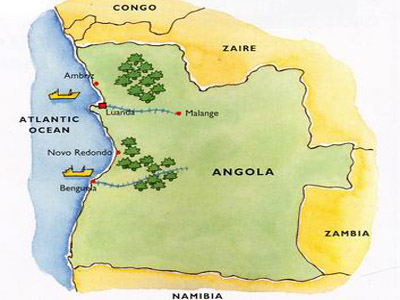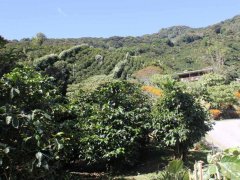Angola, once a big coffee producer, now has an uncertain future. Is it good?

For professional baristas, please follow the coffee workshop (Wechat official account cafe_style)
In the mid-1970s, Angola (Angola) exported 3.5 million bags of coffee a year, 98 per cent of which was Robbins (probably the best Robbins in Africa), but total production fell to 200000 bags in 1990.
The best brands in Angola used to be Ambrish (Ambrish), Ambalem (Amborm), and New Ridondo (Nuo and Redondo), all of which are known for their consistent quality. Most of Angola's coffee is exported to the United States, the Netherlands and, of course, Portugal.
Angola has a history of growing coffee for more than 100 years and is the fourth largest coffee industrial country in the world. Its output ranked first in Africa until 1960. In the mid-1970s, 98% of Angola's annual coffee exports were Roberts coffee. It is the best quality Robbins coffee in Africa. In 1974, Angola's coffee production reached an all-time high of 225000 tons, ranking second in Africa and fourth in the world.
The coastal lowland of northern Angola is vast, about 100mur200 km. Because of its low and flat terrain, low rainfall and semi-dry plants, it is an important coffee production area in Angola. Coffee is grown at the height of 400--l500 meters, with a rainfall of about 1250 mm. The northern region is the main coffee production area in Angola, which was later introduced.
Arab varieties are grown in the central plateau.
Angola used to be one of the largest coffee producers in the world, with most of its coffee exported to countries such as the United States, the Netherlands and Portugal. But the subsequent 27 years of civil war led to a significant decline in coffee production in Angola. In order to revive the former coffee producing country, the Angolan government is increasing investment and adopting preferential policies to encourage companies and farmers to grow coffee, increase coffee production and profits, and implemented a small loan scheme in 2008. Encouraging each farmer to grow coffee will receive a government discount of US $5000. Strengthen the coffee production program, call on farmers and industrialists located in the producing area to actively invest human, material and financial resources in the cultivation of coffee, encourage local farmers to increase coffee production, increase rural income, and promote the development of rural and urban economy.
Angola produced twice as much coffee in 2009 as it did in 2008, reaching 12000 tons. Total coffee production reached 13900 tons in 2012. Angola's plan to revive agricultural operations will start planting 1.5 million coffee seedlings on 500 hectares of arable land in Amboim province in March 2013, with an additional 5000 tons expected to be produced in 2015.
Due to the coffee planting campaign across the country, Angola is expected to regain its position as a major coffee producer in the world. This is also
It will diversify the development of the national economy and improve the over-reliance of the national economy on the oil and diamond industries. With the continuous implementation and strengthening of the government's policy to encourage the production of cash crops, coffee production in Angola will increase steadily.
Important Notice :
前街咖啡 FrontStreet Coffee has moved to new addredd:
FrontStreet Coffee Address: 315,Donghua East Road,GuangZhou
Tel:020 38364473
- Prev

[introduction to hand-brewing coffee] how to judge: is hand-brewing coffee a gimmick?
At the beginning, some people are interested in making coffee, and there is more than one, which is really gratifying. But after they are interested, they often ask how to rush, which bothers me, because I don't seem to be able to explain it for three or five minutes. Share the knowledge I have learned when I am free. If there is anything wrong, I hope all the experts will come back more often.
- Next

Introduction to the origin of coffee-the characteristics, origin and brand market of Angolan coffee
Professional baristas please follow the coffee workshop (official Wechat account cafe_style) Portuguese news agency reported that Angolan coffee brand Caf Cazengo will export its coffee products to China. Jos Gonalves, the project manager, said the brand would export a total of 54 tons of coffee to China, the United States and Portugal, but did not disclose the export price.
Related
- Detailed explanation of Jadeite planting Land in Panamanian Jadeite Manor introduction to the grading system of Jadeite competitive bidding, Red bid, Green bid and Rose Summer
- Story of Coffee planting in Brenka region of Costa Rica Stonehenge Manor anaerobic heavy honey treatment of flavor mouth
- What's on the barrel of Blue Mountain Coffee beans?
- Can American coffee also pull flowers? How to use hot American style to pull out a good-looking pattern?
- Can you make a cold extract with coffee beans? What is the right proportion for cold-extracted coffee formula?
- Indonesian PWN Gold Mandrine Coffee Origin Features Flavor How to Chong? Mandolin coffee is American.
- A brief introduction to the flavor characteristics of Brazilian yellow bourbon coffee beans
- What is the effect of different water quality on the flavor of cold-extracted coffee? What kind of water is best for brewing coffee?
- Why do you think of Rose Summer whenever you mention Panamanian coffee?
- Introduction to the characteristics of authentic blue mountain coffee bean producing areas? What is the CIB Coffee Authority in Jamaica?

